Revisiting the 1980 SAG-AFTRA Strike with ‘MASH’ Stars, an Emmy Boycott and All-Night Negotiating Sessions: ‘We’re Going to Strike Like Hell’
- Oops!Something went wrong.Please try again later.
- Oops!Something went wrong.Please try again later.
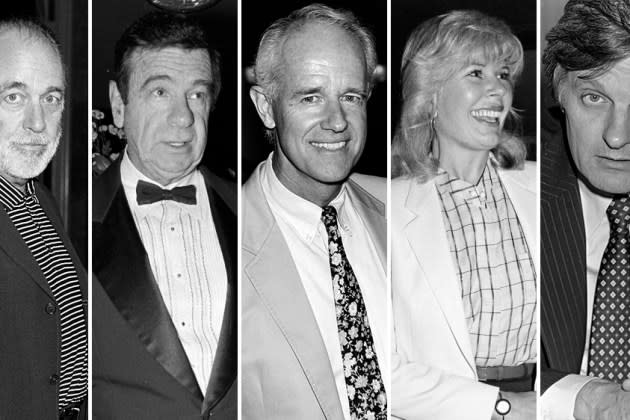
Loretta Swit remembers well the night she won her first Emmy Award.
On Sept. 7, 1980, the “MASH” star sat in her agent’s living room in Beverly Hills, watching the ceremony on TV when she heard her name called out and saw her picture flash on the screen. Swit was not in the audience at the Pasadena Civic Auditorium that year because her union, the Screen Actors Guild, was on strike.
More from Variety
SAG-AFTRA Seeks Approval for Second Strike Against Video Game Companies
NYC Filming Permits Drop 53% in August, First Full Month of Dual WGA and SAG-AFTRA Strikes
Swit and her fellow “MASH” troupers Alan Alda, Mike Farrell and Jamie Farr were among the most vocal and visible actors on picket lines and at press conferences when SAG initiated its first work stoppage in 20 years on July 21, 1980. The reality of her Emmy win – after seven consecutive nominations — sunk in for Swit when she suddenly got a phone call from Europe from her friend Jacqueline Bisset. “She was so excited. She said, ‘Hey, you won!’ ” Swit recalls.
Forty-three years later, Swit is proud of having been a visible and vocal part of an important moment in Screen Actors Guild history.
“My not being there [at the Emmys] did not take away from getting the award. It was wonderful. And I was absolutely glad that’s what we did,” Swit says. “We used a united force against being at the show because we were walking the picket line.”
The virtually star-free 32nd annual Primetime Emmy Awards ceremony is singled out as the public-facing peak of the disruption caused by the strike against Hollywood’s major studios that ran from July 21 to Sept. 25. Industry volatility, however, continued through the contract ratification vote on Oct. 23.
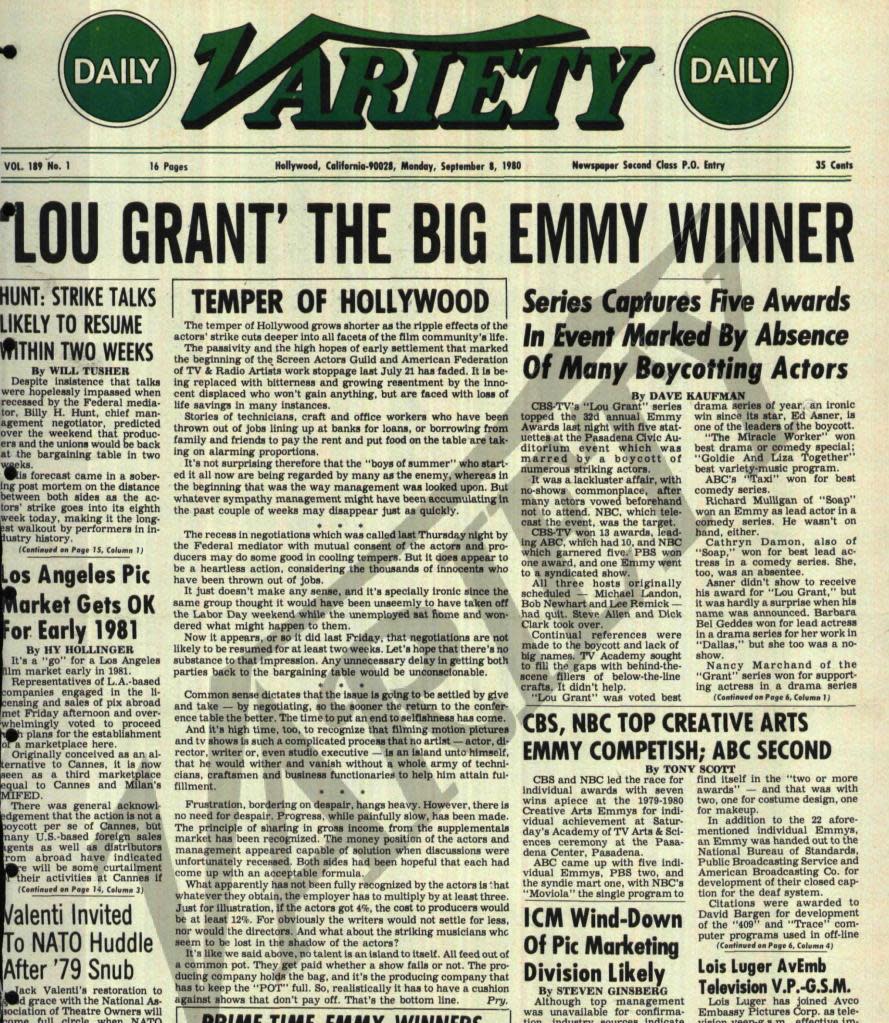
A look back at the bookend year of the Me decade through the pages of Variety reveals familiar patterns of rancor, division, distrust and fear of what the future held in a fast-changing business and technology environment. The actors’ work stoppage unfolded against the backdrop of a beleaguered late 1970s U.S. economy in the grip of inflation and rocked by oil price shocks, among other headwinds. And there was nothing like the staunch level of solidarity among Hollywood unions that has buoyed labor amid the current dual strike of the Writers Guild of America, which went out May 2, and SAG-AFTRA, which struck July 14.
“Frustration, bordering on despair, hangs heavy,” Daily Variety declared in a page-one op-ed headlined “Temper of Hollywood” that ran next to Emmy Awards coverage in the Sept. 8, 1980 edition.
Over the rocky course of the 67-day work stoppage, Ed Asner, Henry Winkler, James Garner, Jane Fonda, Sally Field, Robin Williams, “Dallas” star Patrick Duffy, Howard Hesseman (aka “WKRP in Cincinnati’s” Johnny Fever) and Marlo Thomas were among the prominent names who hit the hustings on that hot labor summer. SAG president William Schallert took a backseat in both the negotiations and PR war to Migden, who was the union’s well-respected longtime leader. Migden is credited with enshrining the principle that actors deserve perpetual residuals for TV reruns.

None other than Charlton Heston, who was president of SAG from 1965 to 1971, thundered out a warning to fellow actors to stand firm in his address to the sold-out crowd on Sept. 16 at a starry Hollywood Bowl benefit event that raised $200,000 for the union’s emergency fund.
“The producers keep telling us the home boxoffice we’re striking over is 10 years away,” Heston said. “We know why we’re here. This is a time for holding on.”
The labor strife in the summer and fall of 1980 created a chaotic environment for the industry, and it sowed division within Hollywood unions. Teamsters members led a wildcat counterpicket outside the Hollywood Bowl fundraiser, complete with a noisy truck drive-by. By late August, IATSE member Joyce Heftel was also making noise and staging counterprotests to hammer SAG and AFTRA on settling the strike. Heftel dubbed her group WOW, for We’re Out of Work.

The tone was set when SAG and AFTRA called a strike without any warning to IATSE, which held its biennial convention in Hollywood, Fla. a week after the strike began.
“I don’t give a —- what they do. They didn’t come to us,” IATSE president Walter Diehl told the IA crowd on day one, as Daily Variety reported on July 29.
In the frenzied strike environment, there were moments of inspiration and moments of desperation. SAG wound up having to publicly apologize to Walter Matthau after accusing him of engaging in strike-breaking publicity activity on behalf of the 1980 thriller “Hopscotch.” SAG spokeswoman Kim Fellner told Variety the union was “delighted to admit we were wrong” after realizing that the Avco Embassy/Landau Co. production did in fact have a SAG waiver. Burt Lancaster did press at the Cannes Film Festival for Louis Malle’s “Atantic City” — and was quick to note that the movie was a French-Canadian production from well north of Hollywood. But Jason Robards bailed on tubthumping on the Croisette for “Melvin & Howard.” George Burns, Art Carney and Lee Strasberg were no-shows for the Venice Film Festival premiere of “Going in Style.”
Vic Tayback – better known as Mel of Mel’s Diner from the CBS sitcom “Alice” — helped organize an actors boycott of talk shows, game shows and other unscripted shows that were technically still open to actors without violating union rules. Studios and PR agencies chafed at SAG’s strict gag rule on actors promoting finished movies, with rumblings about a possible class-action suit against the guild from top praisers and studio ballyhoo chiefs. The union-mandated prohibition against promo was “immoral if not illegal,” groused Warren Cowan, then president of Rogers & Cowan.
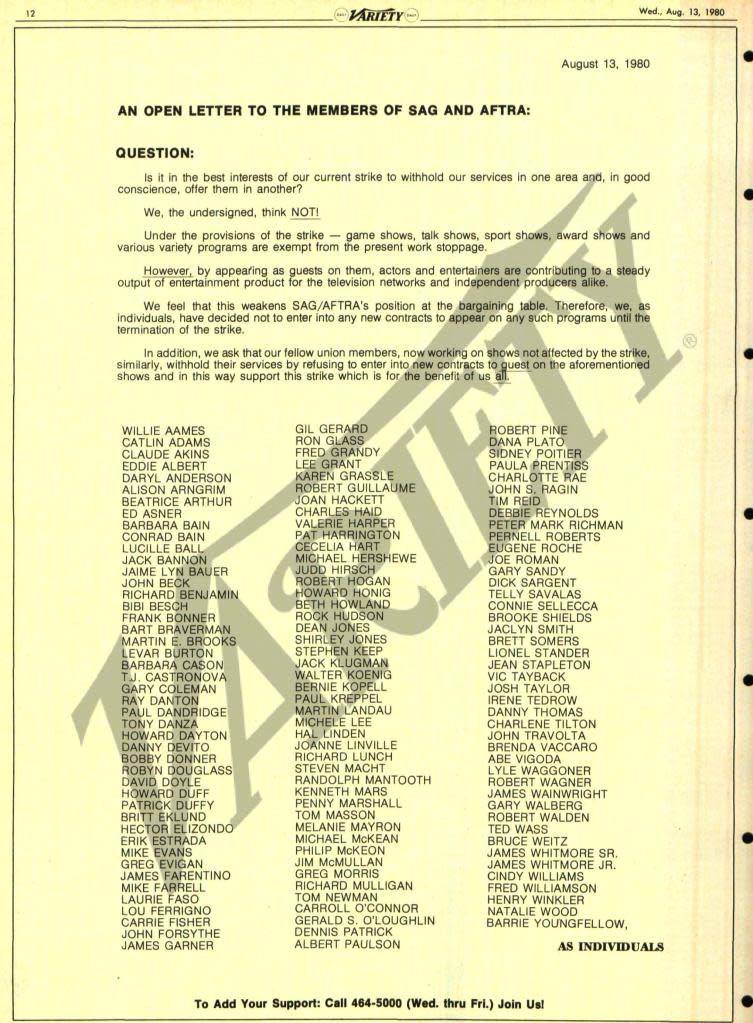
In the end, SAG members were split by the agreement that ended the work stoppage. One of the loudest critics of the hard-fought deal – Asner, then the star of drama “Lou Grant” — would be elected SAG president the following year. In an era long before WhatsApp and Facebook, factions were formed and debates raged, often in dueling ads in Variety’s pages. As the strike hit the eight-week mark, a sense of gloom settled over the business that was broken up only by the hurly burly of on-again, off-again contract negotiations, led by Chester L. Migden, SAG’s national executive secretary and chief negotiator, and Billy H. Hunt, chairman of the Motion Picture Broadcast Industries Negotiating Committee. Before the early 1980s, Hollywood labor negotiations were complicated by the presence of multiple management bargaining units representing different combinations of studios. But by the time of the 1980 strike, the current structure of the industry-wide bargaining unit that is now the Alliance of Motion Picture and Television Producers was coming into focus.
SAG and AFTRA were still separate entities in 1980 (the unions formally merged in 2012) but they frequently joined forces in negotiations on the most lucrative film and TV contracts. At the time of the 1980 strike, SAG represented about 45,000 performers; AFTRA had about 12,000 members. Today, SAG-AFTRA has more than 160,000 members.
“We’re going to strike like hell. We’re going to keep it up full blast,” Migden told Daily Variety on Aug. 6, 1980.
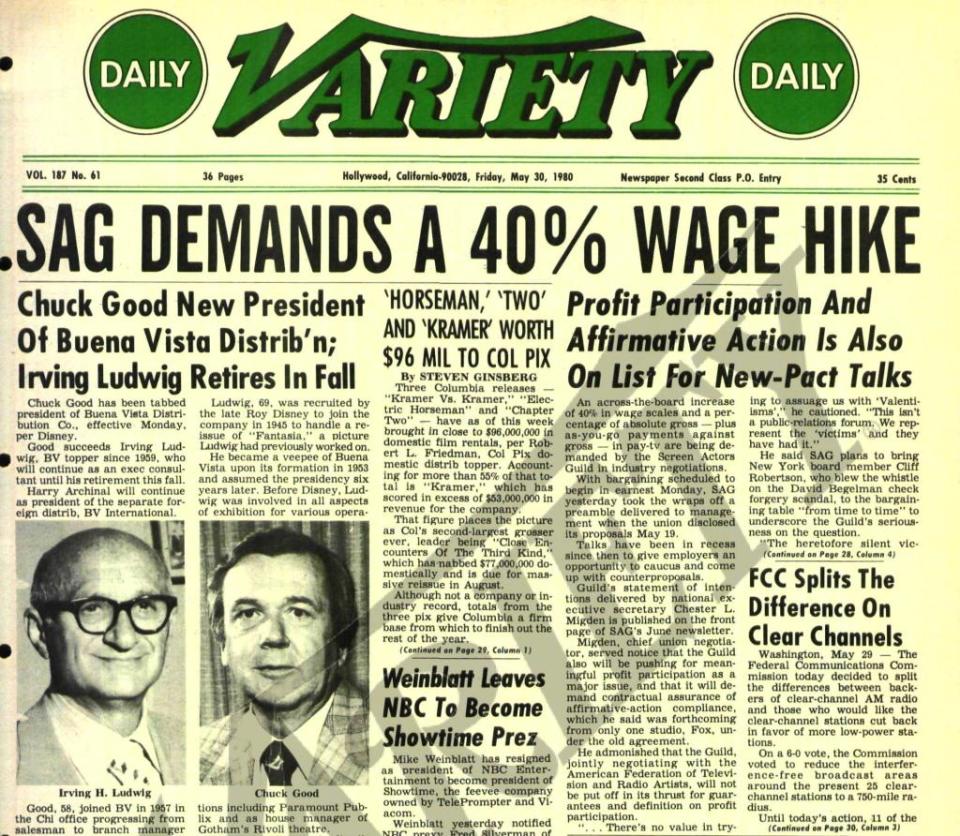
Hunt’s arguments during the long strike echo the sentiments of his contemporaries today. The industry needed time for the burgeoning pay TV and “home” markets for video to develop, Hunt insisted as he asked SAG and AFTRA to wait for a three-year study on the evolution of these markets.
“We have already agreed to pay network TV rates for the production of this product although the market has an audience that is less than one tenth of network size, and we have offered gross receipts participation as residual compensation after certain exhibition requirements been met,” Hunt told Daily Variety on July 23, 1980, explaining the studios’ opposition to “supplemental markets” revenue sharing.
Fellow “MASH” star Mike Farrell shares Swit’s sense of pride in having stepped up on behalf of his fellow thespians when the time came. “MASH” was an enormously successful, critical and commercial hit in its heyday. It was a top 5 hit in the 1979-80 season, tying with “Alice” for No. 4 behind “60 Minutes,” “Three’s Company” and “That’s Incredible.”
“We were asked to go to different places and stand up for the union. We did a lot of talking to the press,” Farrell recalls of the 1980 strike. “It was the right thing to do. I was very lucky in my career and I had the good luck to get ‘MASH’ which was a once in a lifetime experience. I felt grateful to the business for the opportunity that had been presented to me. So I wanted to stand up for the people who were coming up behind me. That’s just the nature of what one does in this business.”
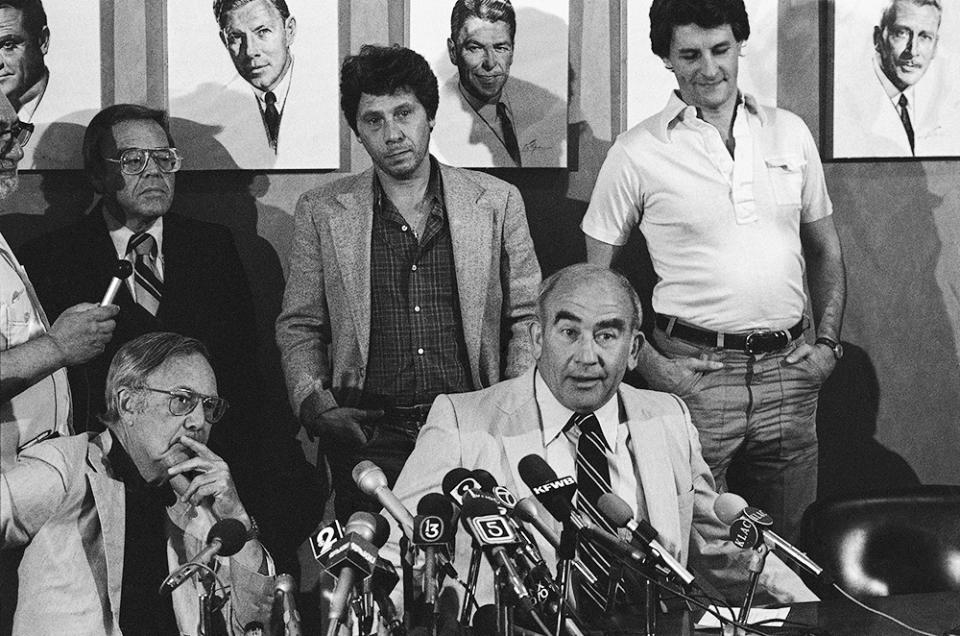
In an era when sunscreen was known as “suntan oil,” Swit recalls hot days of picketing outside major studios. Back then, SAG and AFTRA targeted one studio at a time for four or five days of picketing. The first big assembly was held July 24 in Burbank outside of Warner Bros., which at the time was called The Burbank Studios as the lot was jointly occupied by WB and TriStar Pictures. A high-water mark for 1980 picketing came on Aug. 21 when some 4,000 union members gathered outside of Disney’s gates in Burbank. The crowd included an estimated 500 kids in costumes who took part in a “kiddie picket,” singing Disney songs accompanied by a small band. (Later, there was consternation among industry insiders as to whether the kids should have been exposed to such heat in Burbank.)
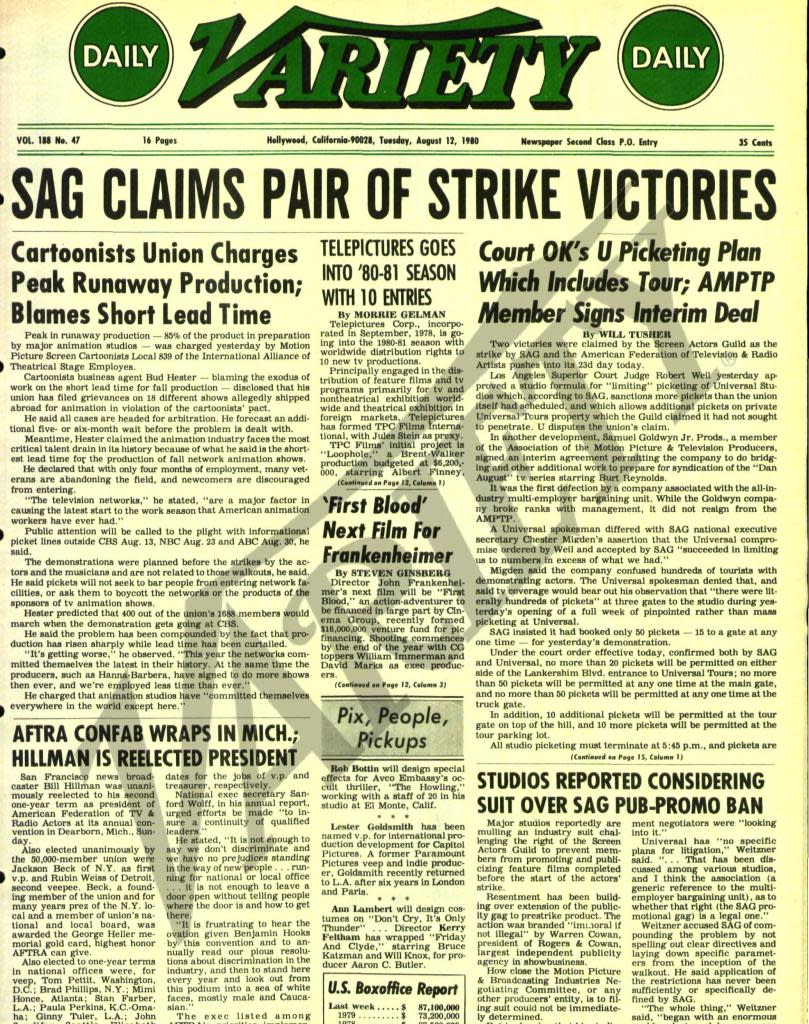
From the some-things-never-change department, there was agita and legal skirmishes over picketing access and safety around the Universal Studios lot on Lankershim Boulevard, just as there has been in recent weeks. In August of 1980, the sight of movie and TV stars picketing up and down the street led to a three-mile backup on the nearby 101 freeway. Hesseman was spotted “urging a carload of tourists who were held up in traffic to detour to Magic Mountain, where he said it was cheaper and more fun,” as Daily Variety reported on Aug. 14, 1980.
As Ronald Reagan campaigned to boot Jimmy Carter from the White House, SAG and AFTRA negotiators were in and out of Hunt’s headquarters, which were located near the intersection of La Cienega and Beverly boulevards. A federal mediator was brought in twice to help bridge the chasm. On Sept. 4, 1980, industry insiders gnashed their teeth as mediator Timothy O’Sullivan insisted the sides enter a “cooling off period,” ordering that talks be recessed for what turned out to be 13 days.
Once the negotiations resumed, there were all-night bargaining sessions to get to the finish line. SAG’s Migden had what was described as an “allergic reaction to his aftershave” on Sept. 23 and was taken across the street to Cedars-Sinai Medical Center, but he returned after an hour. On Sept. 25, after a 19-hour bargaining session that ended at 5:30 a.m., the sides emerged with a tentative three-year pact.
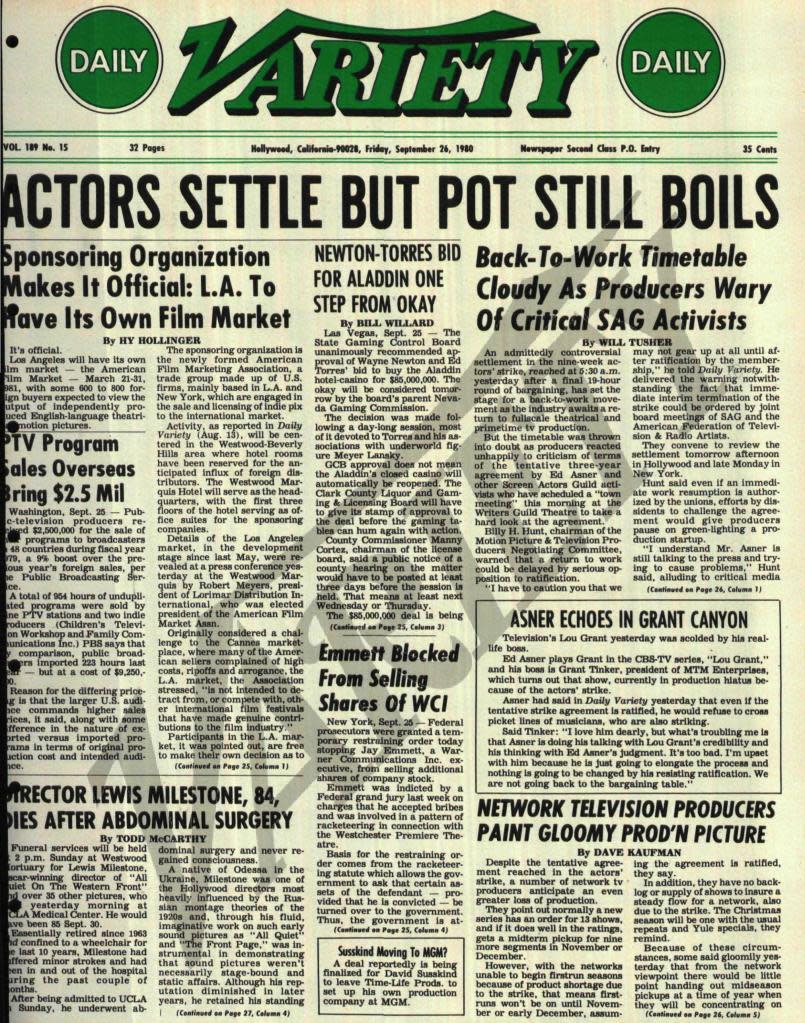
As for the two biggest flashpoints of the talks – the unions’ demand for a double- digit hike in minimums and a cut of the revenue from “supplemental markets” including cable and home videocassettes and disks – SAG and AFTRA achieved gains that required significant compromise. SAG wound up with a 15% boost in minimums for the first 18 months of the contract, followed by another 15% in the second half of the deal. On the supplemental markets issue, SAG crafted several revised proposals to get a piece of the “first-dollar” pie. But in the end the union agreed to a more traditional residual formula to cover the “home boxoffice” formats that Heston warned of. SAG also made a big concession on the issue of “floating time,” the studios’ demand that actors on hourlong dramas make themselves available for work withhold holding fees for three weeks per season at the producers’ behest. Management, for its part, kicked in another 1% in annual contributions to the SAG health fund to establish the union’s first-ever dental coverage plan.
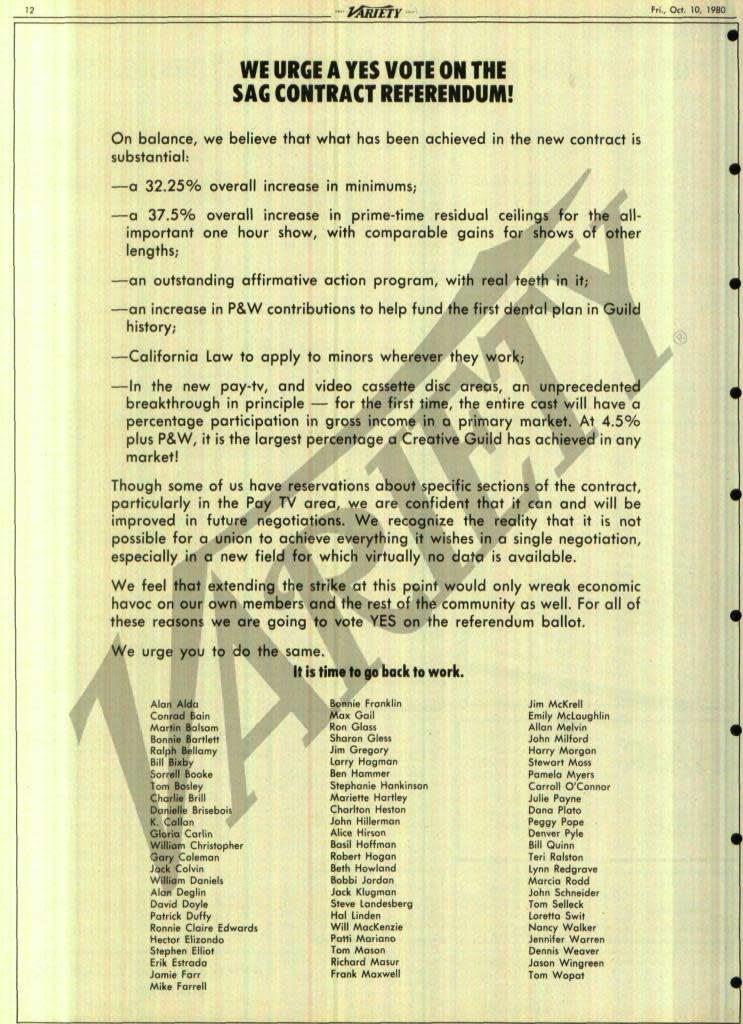
SAG and AFTRA issued return-to-work orders a week after the tentative agreement was struck. But that didn’t end the industry drama because of the concern that SAG members in particular might not ratify the deal. SAG held member meetings at the Hollywood Palladium and Writers Guild Theater in early October that were raucous, with a report that Asner and actor Jennifer Warren “clashed verbally” over the merits of the deal. Asner later joined a group of actors who held a news conference outside SAG headquarters (then on Sunset Boulevard, a few blocks east of Fairfax Avenue) urging members to reject the deal.
Ultimately, the “Lou Grant” star – who won the best drama actor Emmy that year for his role as a crusading newspaper editor – was gracious in defeat. The SAG contract was ratified by 83.4% of the more than 22,300 members who voted.
“The vote merely shows the eagerness of people to get back to work. I wish everybody well,” Asner told Daily Variety. “We will have to back up and regroup and make up for it in the next contract.”

The resolution of the 1980 strike was even tougher on the “tooters,” as Variety cheekily described the American Federation of Musicians. The AFM failed to achieve its major goal of establishing TV residual payments for composers in the strike that began in early August and ended Jan. 13, 1981. After five and a half months that devastated the finances of many members, the union came away with only a 9% hike in minimums over three years. The AFM’s negotiating committee sent the deal for a ratification vote with no recommendation.
“We would have liked more,” Local 47’s Louise DiTullio acknowledged at a Jan. 20, 1981, AFM press conference.
The industry gods were much kinder to Swit. She went on to earn three more Emmy nominations for her work as Nurse Margaret “Hot Lips” Houlihan on “MASH.” She was able to accept her statuette on stage in 1982 when she won for the second time.
But Swit has even stronger memories of how the “MASH” team celebrated the following year during their final outing together at the Emmys. The storied black comedy series, inspired by the Robert Altman film and Ring Lardner Jr. novel, made a triumphant exit after 11 seasons in February 1983 with a record-shattering finale episode, “Goodbye, Farewell and Amen,” directed by Alda.
Like Farrell, Swit stresses that cast, crew and producers who served together in the 4077th became a genuine family, strengthened by friendships that endured. When it came time to attend the Emmys on Sept. 25, 1983, the show had already been off the air for seven months. Somehow or another, a plan was hatched to rent a bus to bring the “MASH” contingent to the ceremony at the Pasadena Convention Center.
“It was our last Emmy show. Instead of going in those long limos that the networks would send, we hired an old bus so we could all go together,” Swit says. “I’ll never forget pulling up in this bus and all of us getting off with our bling and our black tie. We just wanted to be together. ‘MASH’ was and still is a very special group of people.”
(Pictured top: Actors Howard Hesseman, Walter Matthau, Mike Farrell, Loretta Swit and Alan Alda)
Best of Variety
Oscars Predictions: Best Actress - Festivals Declare Emma Stone and Jodie Comer Awards Contenders
The Best Early Labor Day Sales to Shop Right Now: Le Creuset, Nespresso, North Face and More
Sign up for Variety’s Newsletter. For the latest news, follow us on Facebook, Twitter, and Instagram.

